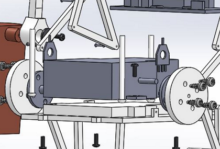Fall 2016 Biped Trade Off Study- Ankle Servos
Table of Contents
Ankle Servo Selection
By: Alan Valles (Electronics and Control Engineer)
Approved by: Ijya Karki (Project Manager)
Introduction
The most recent design calls for 4 servos to be utilized. Two servos will function to shift the center of mass onto the planted foot during walking motion. The remaining servos will as the ankle which will allow the robot to turn during walking motion.
Study
Since there are four different servos that have different requirements, the ankle servos will be compared. The other servos are still to be determined so that the necessary torque required to move the CoG to balance while turning is considered.
| Servo | MFG | Voltage | Torque(stall) | Mass | Cost |
| 9g | Varies | 4.8-6V | 18.9 oz-in | 9g | Free(3.95) |
| ES08A | Emax | 4.8-6V | 21oz-in | 8.5g | 4.95 |
| HS-53 | Hitec | 4.8-6V | 16.70z-in | 8g | 7.19 |
Under ideal conditions, the CoG will be directly on top of the shaft therefore, torque requirements will be dependent based on the position of CoG and total weight of the robot. Due to these assumption, all of the servos will meet the torque requirements. Therefore, the primary constraint will be cost. This leads BiPed to utilize existing TRC inventory and select the 9g servo. If the servos were to be bought due to stripped gears on existing parts or other issues with inventory, the Emax will be purchased depending on the total budget of the robot due to other subsystems.
Conclusion
In conclusion, the current existing inventory of 9g servos will be used for the ankle servos. This is due to the primary constraint.
Resources
[1]http://www.robotshop.com/en/9g-micro-servo-motor-4-8v.html#description
[2]http://www.emaxmodel.com/es08a-ii.html
[3]http://www.robotshop.com/en/hs-53-feather-nylon-gear-servo-motor.html










